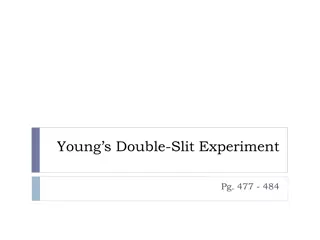Progress on R&D of the WCDA Experiment
This report details the progress of the Water Cerenkov Detector Array (WCDA) experiment conducted by Mingjun Chen on behalf of the WCDA Group. It includes information on the introduction to the experiment, R&D of the Water Cerenkov Detector Unit, measurement of muon events, water quality control, progress on the engineering array, PMT testing, slow control, calibration system, and physics details. The report outlines the construction phases, event milestones, water purification, muon event measurement, and simulation studies of the experiment.
Download Presentation

Please find below an Image/Link to download the presentation.
The content on the website is provided AS IS for your information and personal use only. It may not be sold, licensed, or shared on other websites without obtaining consent from the author.If you encounter any issues during the download, it is possible that the publisher has removed the file from their server.
You are allowed to download the files provided on this website for personal or commercial use, subject to the condition that they are used lawfully. All files are the property of their respective owners.
The content on the website is provided AS IS for your information and personal use only. It may not be sold, licensed, or shared on other websites without obtaining consent from the author.
E N D
Presentation Transcript
PROGRESS ON R&D OF THE WCDA EXPERIMENT Mingjun Chen On Behave of WCDA Group Feb18, 2011
Outline 2 Introduction to WCDA experiment R&D of Water Cerenkov Detector Unit Measurement of the muon events Water quality control Progress on the engineering array PMT test Slow control Calibration system Summary
WCDA experiment 3 Physics details, please see Yao Zhiguo s report. This report will focus on R&D of the WCDA experiment. Four steps: A unit of water Cerenkov detector(one cell) at IHEP. A engineering array(9 cells) at YBJ. A array(900 cells). Full array(3600 cells). 1. 2. 3. 4. Step 1 was done. And the engineering array goes smoothly now.
Unit of water Cerenkov detector 4 Diameter:7m Height: 5m Water purification system
Main events of the unit 5 April,2009 Construction was done And the First PMT deployed. June,2009 Replaced with a new water-proof PMT, and start events taking. April,2010 Replaced with a Hamamatsu R5912 PMT June,2010 Black PE film was hung inside the water tank. And the water recycling and purification was upgraded. August,2010 Study on the water quality, and solve the problem of the stability of the water quality.
Measure the muon events. 6 The vertical and central muons, which cross the tank, are selected. Dotted line is from the simulation(scale up 5.2%) real line is experimental data. The second peak in the muon spectrum was FOUND! The second peak in the muon spectrum was FOUND! It comes from that the photo It comes from that the photo- -cathode of PMT is directly hit by the charge particles! hit by the charge particles! A possible method to calibrate the system. A possible method to calibrate the system. cathode of PMT is directly
Study on the components of the second peak by simulation 7 Black line all processes 564.2 Red line A 505.0 Blue line B 487.7 Pink line A&B 439.3 Green line A&B&C 391.9 Contribution from -ray & MSC (B-A&B)/B = 10% Contribution from uneven QE (A-A&B)/A=13% Contribution from the boundary effect and thickness of glass Three cases Without -ray and MSC process A. (A&B-A&B&C)/A&B=11% Uniform QE(A/An = 1) B. Consider QE and track length: C. Without the glass boundary effect and thickness of glass is 0.01mm A&B&C / 6.3 / 60 = 1.04 Only 4% difference is left. Note Case B and C are related
Rise time measurement of muon signal 8 Tektronix TDS 3054B scope Vertical muon events selected 8-in R5912 PMT at Gain106 Typical RT from datasheet: 4ns; Typical TTS from datasheet: 2.2 ns Results Min. value 4.3 ns PMT RT; MPV 5.1 ns Including the difference of PE s arrival time Smaller amplitude, wider RT distribution measurement error TTS scattering of Cerenkov light
Single rate measurement of PMT signals 9 PMT HV @ +1350V(3.4*106) 16 s waveform is recorded and analyzed by the FADC electronics. Results 16.9kHz @ 1/4PE 9.2 kHz @ 1PE Very small rate of large PEs.
Water recycling and purification system 10 After three months hard work, water quality is controlled Organic carbon is the main problem for the water quality. One UV light(185nm) was added. Filter with three levels: 5 m 1 m & 0.22 m. >10m of water attenuation length is already kept for more than 3 months.
Joint measurement with 43 plastic scintillator detectors. 11 August12th-18th 705K events are taken. events has the signals from the center 8-in PMT. PMT HV :1072 V Gain 0.61 106 1 pC = 10 PE Simple estimation MPV = 3.3 pC 10 PE/pC = 33 PE 25 m2 (5 particles/5 m2 5/40) 10 (gamma 0.8 PE/particle = 24 PE! Peak position is close to the estimation
Some related distributions 12 Distribution of two 8-in PMTs charge. Distribution of the reconstructed core distance and two 8-in PMTs charge.
PMT Potting 17 Soft sealant Epoxy Signal & HV cables Nine PMTs were potted successfully.
PMT test for the engineering array. 18 The following parameters are tested: Single Photo-electron(P/V) HV VS. Gain Non-linearity Dark noise rate with different thresholds Earth magnetic effect Rise time TTS PMT test stand Calibration of PMT test stand: Overshoot simulation of PMT signal Attenuation of PMT signal cable Calibrate the pre-amplifier Calibrate the FADC system. Temperature effect of HV system
PMT test process 19 Before the potting: Three days burn-in; SPE,P/V, HV VS. Gain, linearity and dark noise rate were measured. After the potting: SPE,P/V,HV VS. Gain, linearity, dark noise rate, rise time and TTS were measured. Detailed studies on PMT s performance: Relation between P/V and different HV Relation between P/V and different LED light intensity Relation between BETA and different LED light intensity Stability of BETA value(<2%) Relation between BETA and different HV range(<2%). Stability of PMT test system(<2%).
Schematic of PMT test 20 Pulser Generator trigger FADC PC Pre-amplifier ~26X Discriminator Scaler HV SPE measurement LED method, 405nm LED pulsed 1KHZ Gain@2*106 (SPE events/total events)=~10% Non-Linearity Two LEDs method Non-L(%)=(C-(A+B)+pedestal)/(A+B-2*pedestal)*100%
Hamamatsu 8-in PMT: SD2590 21 HV VS. Gain SPE measurement Non-linearity
Dark noise rate(SD2590) 22 Amplitude VS nPE Amplitude is got from the scope Number of PEs is taken by FADC Amp=2.641 nPE Threshold (PE) 1/4 1/3 1/2 1 2 Rate (kHz) 0.98 0.90 0.83 0.65 0.20
TTS measurement SD2514 23 Wavelength:466nm FWHM:90ps PMT CFD TDC Pico-second Laser HV V Sigma ns 1200 1.06 1230 0.97 1250 0.93 TTS FWHM 1.01 2.35 = 2.49 ns Reproducibility ~0.2ns TTS value is close to the datasheet.
Table of PMT test Non_line Non_line arity arity (<10%) (<10%) 820 Dark noise Dark noise rate rate >1/2PE >1/2PE 1.01KHZ PMT No. PMT No. HV HV V) V) P/V P/V Beta Beta TTS TTS (ns) (ns) Rise Rise time(ns) time(ns) SD2585 2.50 7.98 1266 1.86 3.2 SD2602 2.39 8.48 934 1.92KHZ 1265 2.02 3.2 SD2538 1164 4.68 8.05 745 0.52KHZ 2.37 3.4 SD2514 1213 3.53 8.01 680 0.94KHZ 2.49 3.3 SD2580 1279 2.76 8.43 730 0.65KHZ 2.04 3.2 SD2586 1248 4.30 7.83 730 1.41KHZ 2.30 3.3 SD2559 1132 5.84 7.92 625 0.95KHZ 1.93 3.3 SD2576 3.30 7.88 620 1.01KHZ 1215 2.16 3.2 SD2590 3.50 7.78 764 0.83KHZ 1273 2.59 3.2 24
Optical calibration system 25 To calibrate the stability of the whole system, and it also could monitor the PMT gain by LED method. PC ADC/TDC PMT Signals Light Source LED 30m/45m optical fibers Reference PMT Status: Fibers are ready; All parts are already tested; Uniform light source is not perfect yet.
Joint test of electronics/DAQ system and PMTssignal. 26 Arrival timing difference of ch4 and ch2 Electronics system is developed by USTC, based on 9U VME standard. More details, please see Hao Xinjun s report. During the middle of Jan., Electronics system was connected with 8 PMTs. SPE and arrival timing difference are studied. Sigma.3.10ns Arrival timing difference of ch9 and ch8 Sigma.3.06ns SPE spectrum of channel 8 LED method and 2 channels fired
Trigger mode. 27 Within 100ns, 3 channels of nine PMTs are fired; 2 channels of nine PMTs are fired ,filtered with 1/100(only one trigger outputs when 100 times); 1 channel is fired, filtered with 1/10000 1Hz force trigger External trigger(Possibly from ARGO-YBJ or other detectors) The above five cases work with OR mode. nPMT Rate (Hz) Int. Rate (Hz) Simulation of the trigger rate. 1 44800 48408 2 3100 3608 3 298 508 4 92 210
More selections of PMTs 28 Since ~4000 8-in PMTs are required by WCDA experiment, we also consider other products besides Hamamatsu company. Two 8-in PMT were bought from the Electron Tube company. It has better linearity and worse timing compared with Hamamatsu s. A prototype of 8-in PMT(the left one) was made by a domestic factory. It indeed works, but need more optimization. LED light source is used and work with same Gain(2*106) Rise Time Fall Time ET 9354KB 6.9 ns 13.7 ns Hamamatsu 4.6 ns 6.3 ns
Test of ET 9354KB PMT 29 Beta=16.94 HV +1260 V 2.08 106 Gain
Design of the water recycling and purification system. 30 Water inlet outlet 0.2um filter 5um filter 1um filter Active carbon Quartz sand UV light Schematic of water purification system Recycling ability: 1 volume/month.
Slow control system of the engineering array 31 Online setup of water attenuation length measurement Used to monitor the water quality; It will automatically measure the water attenuation length everyday. Environment monitor system Room temperature and humidity of the control room Water temperature of the water pool Water level PMT HV protection system Once light leak in the water pool, PMT HV will be shut down immediately. Concept design was done. The joint test with the sensors and setup was tested. The group from the Center for Space Science and Applied Research, CAS, is responsible for this slow control system.
Schedule of the engineering array 32 Content Progress or Status PMT related Potted, tested and ready. Water pool building Construction was done in last September. Black film inside the water pool Part was done. It will be finished by April Slow control system Should be deployed by April. DAQ system Joint test was done and ready. Water recycling and purification system Concept design was done. Will be deployed by May. Data taking will start in June!
Brief Summary 33 R&D of the unit of the water Cerenkov detector was done. The second peak in the muon energy spectrum is found and well studied. Water quality control is studied. It gives us much experience for the future experiment. The engineering array goes smoothly. After about four months' hard team work, we hope that we could run this array in June.
34 Thanks.
Backup 35
36 2010 1-2 3 MACRO PMT 4 PMT 5 5 10 R5912 PMT 12-16 17-24 25-30 31 6 PMT
>10m >10m m m Water attenuation length Measurement setup. Red points Red points 1) 2) 3) ( ) 10 10 40
PMT P/V PMT +1213V 6 6 P/V 4.53 0.6 13.2% 2.03 0.03 1.5% PMT PMT SPE (2.0 0.1) 106 5% P/V P/V +1213V LED LED SPE SPE 13.8% 13.8% PMT SPE P/V P/V 9 P/V LED (2.04 0.07) 106 LED LED beta beta PMT beta beta beta LED 100 beta 7.97 8.00 beta 41
TTS TTS Transit time spread jitter 42 - TTS Pico-second laser source Hamamatsu C10196 Features Pulse width FWHM less than 100 ps High stability, low jitter Application Pulse response measurements of high-speed photo-detectors FWHM: 70 ps Wavelength: 466 nm
WCDA PE smearing PE 1 PE 42.6% 2 PE 18.4% PE nPE>2000 2 10-4 7 10-4 E>5 TeV 30% smearing nPE<1000 nPE<50000 nPE>0 nPE>2 0.5 2000 PE 44 44
46 LED/ + ADC&SPE hit Cluster A Cluster cluster PMT B 200 ns 5






















